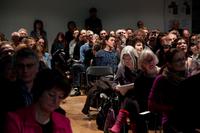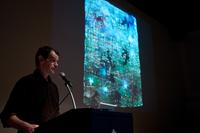Programme
The artist as researcher
Royal Academy of the Arts (KABK), The Hague (NL)
A two-day international conference on artistic research and the PhD in visual art and design.
PAUL CARTER
Lecture by key note speaker Paul Carter, creative director of Material Thinking; Professor at Melbourne University with an introduction by Janneke Wesseling.
Paul Carter is a writer and artist based in Melbourne (Australia) who has explored the interface between image and text in a number of significant public artworks and performance-based site interventions. His books The Road to Botany Bay (1987; 2009) and The Lie of the Land (1996) offered radical re-readings of the poetics of colonisation, laying the groundwork for a place-making practice that now manifests itself through his creative research studio Material Thinking. In books such as Dark Writing (2008), Mythform (2005) and Material Thinking (2004) he has sought to define the difference of the knowledge that creative research produces, and to annotate the techniques it uses. In Repressed Spaces (2002) he explores the psychology, phenomenology and poetics of a sustainable urbanism. His current book-in-progress Ground Truthing explores the concept of regions through the recovery of the poetic history of the Mallee, a region of semi-arid Australia. His best-known public space intervention is Nearamnew (Federation Square, Melbourne) and through his studio he is currently working on the design and program for a major new coast edge cultural facility in Darwin. Paul holds Honorary Professorships at a number of Australian universities and is Foundation Chair of Creative Place Research at Deakin University (Melbourne).
STEPHAN DILLEMUTH
Lecture by key note speaker Stpehan Dillemuth, visual artist; Professor at the Academy of Fine Arts, Munich with an introduction by Janneke Wesseling.
Stephan Dillemuth is an artist who sees art as a tool for artistic research and critical reflection on the circumstances of contemporary life. His inquiry into recent changes in the idea of the public sphere takes place against the backdrop of our globalised, localised and fragmented publics. Considering the impact of lifestyle as a new ideology of self-fulfilment and liberation, Stephan Dillemuth has investigated the Boholand and German Lebensreform movements at the turn of the 19th to the 20th century.
GRAEME SULLIVAN
Lecture by key note speaker Graeme Sullivan, Professor of Art Education, Teachers College, Columbia University, New York, with an introduction by Janneke Wesseling.
Graeme Sullivan is Professor of Art Education, Teachers College, Columbia University. His research involves an ongoing investigation of critical-reflexive thinking processes and methods of inquiry used in the visual arts. These ideas and approaches are described in his groundbreaking book, Art Practice as Research, which has recently been substantially revised and updated in a second edition. He is the author of numerous articles published in the United States, United Kingdom, Europe, Australia and Asia that explore the creative and critical approaches used in studio-based research. He maintains an active art practice and his Streetworks have been installed in several international cities and sites over the past ten years.
KITTY ZIJLMANS
Lecture by key note speaker Kitty Zijlmans, Professor of Contemporary Art History and Theory, School of Art History, Leiden University, with an introduction by Janneke Wesseling.
Kitty Zijlmans is Professor of Contemporary Art History and Theory at the University of Leiden since July 2000. She is chair of the Steering Committee of the Research Program Transformations in Art and Culture, funded by the NWO, the Dutch National Organization for Scientific Research. Since January 2006, she is member of the advisory committee BKV of the Dutch Council for Culture. Since January 2009 she is advisor for NWO / dept. Humanities. Her main interest is in the fields of contemporary art, art theory, and methodology. She is also especially interested in the position and contribution of women in art and culture, and the ongoing intercultural processes and globalization of the (art) world.
HENRI JACOBS
Lecture by key note speaker Henri Jacobs, visual artist, Brussels; Rietveld Research Resident Amsterdam 2009–2010, with an introduction by Janneke Wesseling.
Henri Jacobs (Zandoerle, NL, 1957) has been living and working in Brussels since 1993. He studied at the St. Joost Academy in Breda, the Academy for Visual Arts in Rotterdam and the Rijksacademie in Amsterdam. From the autumn of 1990 he spent a year as an artist-in-residence at the Van Doesburg House in Meudon, France. His paintings and drwaings have been presented in solo and group exhibitions in galleries and museums in Brussels, Bruges, Amsterdam, Rotterdam, Eindhoven , Tilburg, New York, Paris and Venice. The oeuvre of Henri Jacobs now includes various small- and large-scale art commissions in Amsterdam and elsewhere. Since December 2003 he has been producing a constant stream of drawings. He regularly posts theseJournal Drawings, for which he employs himself as a visual database, on the ‘Journal’ pages of his website. Since Septmeber 2009 Jacobs has been engaged in a two-year artistic research about the palimpsest, which was followed by an investigation into creation and destruction. That artistic research has evolved into a study about idolatry and iconoclasm.
AGLAIA KONRAD
Lecture by key note speaker Aglaia Konrad, visual artist, Brussels with an introduction by Janneke Wesseling.
Aglaia Konrad is artist and photographer, based in Brussels. She teached at the Jan Van Eyck Academy in Maastricht till the end of 2007 and is currently teaching at the Hogeschool Sint Lukas, Brussels. Her work has been presented in solo exhibitions in Siegen, Antwerp, Geneva, Graz, Cologne, New York, as well as in international collective shows: Dokumenta X (1997), Cities on the Move (1998-1999), Orbis Terrarum. Ways of Worldmaking (2000), Talking Cities (2006). The work got summerised through several books such as Elasticity (2002) and Iconocity (2005). Metropolitan urban space forms a key focus in her photographical work. Since the early 1990s, she has been exploring the post-war urban landscape and its various manifestations in a wide array of mega cities on different continents. Aglaia Konrad discovered the Egyptian ‘Desert Cities’ during a brief visit to Cairo in 1992, becoming intrigued by the vast scale of this long term project. The project she instigated explores the application of modernist principles to the architecture of the new cities that have been emerging over the last 15 years, but still seem hardely occupied. Reflecting on these dwellings that developed alongside archeolocical sites in an exoticised landscape, the project questions urban planning strageties in a society where the consequencies of recent social reforms have not yet fully materialised. The 2004 Award Grand Prix de la Ville de Veveyallowed to set the outlines for this artistic research on ‘Desert Cities’. Various stages of audio-visual production on the topic have already been shown in Vevey, Nancy and Essen. The book Desert Cities frames the last phase of the project research, the making of which was in large part made possible by the 2006 Albert Renger-Patzsch-Award.

